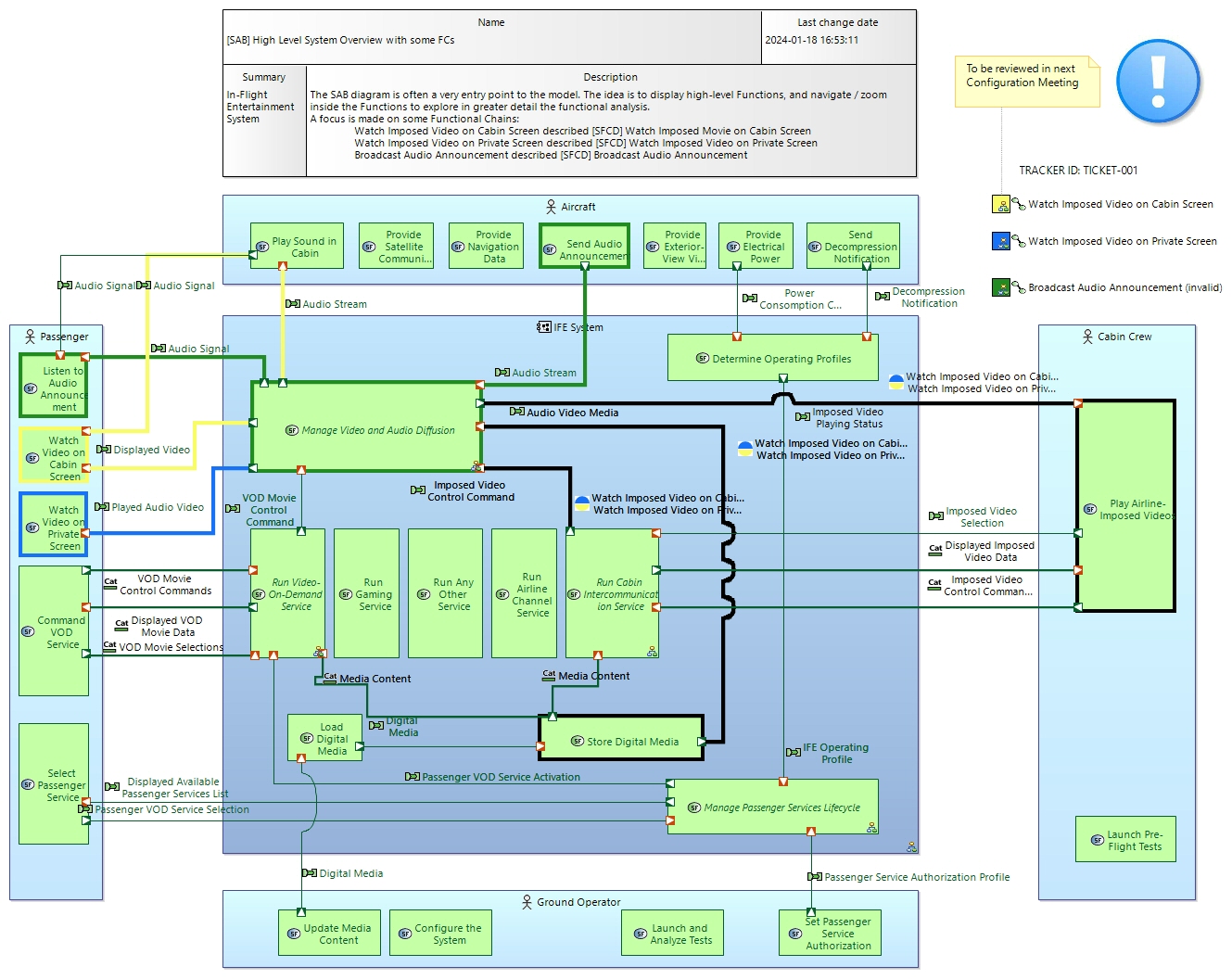IFE System
SystemComponent
In-Flight Entertainment System > In-Flight Entertainment System > System Analysis > Structure > IFE System In-Flight Entertainment System
It is an overly simplified vision of what a real in-flight entertainment system is: IFE System described as a backbox, interacting with Actors:
The system is globally organized as follows:
- Cabin crew services are always available, passenger services have to be activated. Their availability depends on the flying conditions and on the class the passengers
are flying in - The system is able to store digital media content
- Most of the interactions of the passengers with their services (navigating between menus, selecting movies, etc.) are captured in functions called “Run <xxx> service”
- Services rely on audio and video broadcast means
- Maintenance and configuration topics are only evoked
The [MCB] All Missions and Capabilities diagram shows on the capabilities of the IFE system. Three other diagrams provide interesting entry points to the model:
- [SC] System Actors lists all the Actors (the aircraft is considered as an actor)
- [SDFB] Top Level Functional Overview provides a first functional overview of what the actors actually do and what kind of exchanges they have with the IFE system
- [SAB] Top Level System Overview and its slightly refined version [SAB] High Level System Overview are very good entry points to further navigate in the model.
Starting from these high level diagrams, a typical reading path is to dive into the function to visualize their refinement. For example, [SDFB] [CTX] Run Services. And recursively.
Using capabilities as a driver to browse the model is recommended. Some diagrams are specifically marked for that purpose, for instance [SDFB] [CAPABILITY] Provide Video Entertainment Services. From this capability covering VOD services to the passengers, browse the functional chains and scenarios to better understand how the capability is fulfilled.
- Functional chains: [SFCD] Start Playing VOD Movie, [SFCD] Resume VOD Movie
- Scenarios: [ES] Start VOD Service, [ES] Start Playing VOD Movie
Check the global mode machine of the system with [MSM] IFE Operating Modes. Among others, this mode machine is intended to specify under which operational conditions the IFE system is running. Another Mode machine is specifically modelled for what will become the Seat TV: [MSM] Seat TV - Movie Player Modes
Notes:
- Not all the IFE system is modelled. Focus is put on VOD service, audio announcement and imposed videos (safety instructions, ads, etc.).
- While interesting, the topic of the integration of the IFE with the aircraft is kept minimal (according to flying conditions, the IFE system is supposed to behave
differently). - Not all possible Scenarios and Functional Chains have been created.
Features
- Is Actor : false
- Is Human : false
- Is Abstract : false
Allocated Functions
 Manage Passenger Service Interruptions
Manage Passenger Service Interruptions Handle VOD Movie Controls
Handle VOD Movie Controls Store Digital Media
Store Digital Media Handle Service Activation Requests
Handle Service Activation Requests Determine Service Availability
Determine Service Availability Broadcast Audio Video Streams
Broadcast Audio Video Streams Load Digital Media
Load Digital Media  Retrieve VOD Movie Data
Retrieve VOD Movie Data Manage Imposed Video Selections
Manage Imposed Video Selections Handle Imposed Videos Controls
Handle Imposed Videos Controls Determine Operating Profiles
Determine Operating Profiles Run Gaming Service
Run Gaming Service Run Any Other Service
Run Any Other Service Run Airline Channel Service
Run Airline Channel Service
State Machines
Realizing Elements
Owned Constraints
| Name and Description | Owned specification | Constrained elements |
|
[No Name]
No description. |
LinkedText : |
None |
Owned diagrams
SC System Actors

SAB High Level System Overview

SAB Top Level System Overview

SAB High Level System Overview with some FCs

The SAB diagram is often a very entry point to the model. The idea is to display high-level Functions, and navigate / zoom inside the Functions to explore in greater detail the functional analysis.
A focus is made on some Functional Chains:
- Watch Imposed Video on Cabin Screen described [SFCD] Watch Imposed Movie on Cabin Screen
- Watch Imposed Video on Private Screen described [SFCD] Watch Imposed Video on Private Screen
- Broadcast Audio Announcement described [SFCD] Broadcast Audio Announcement
